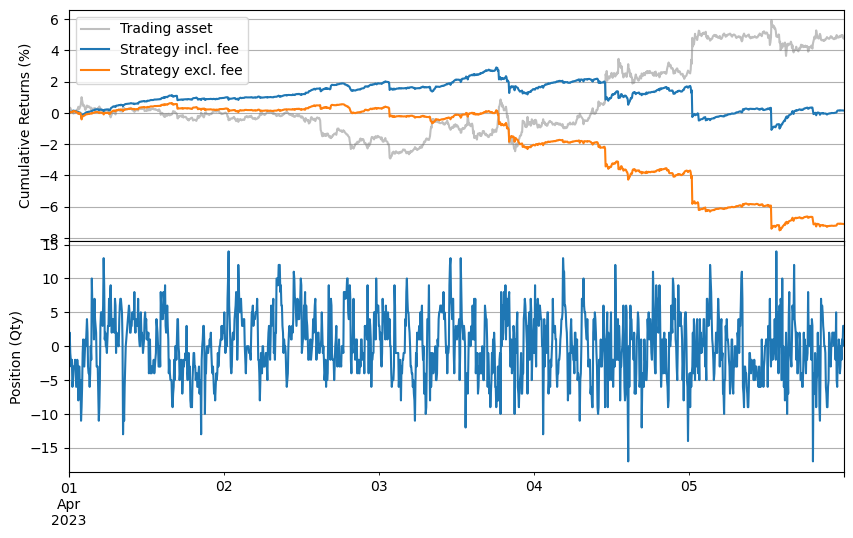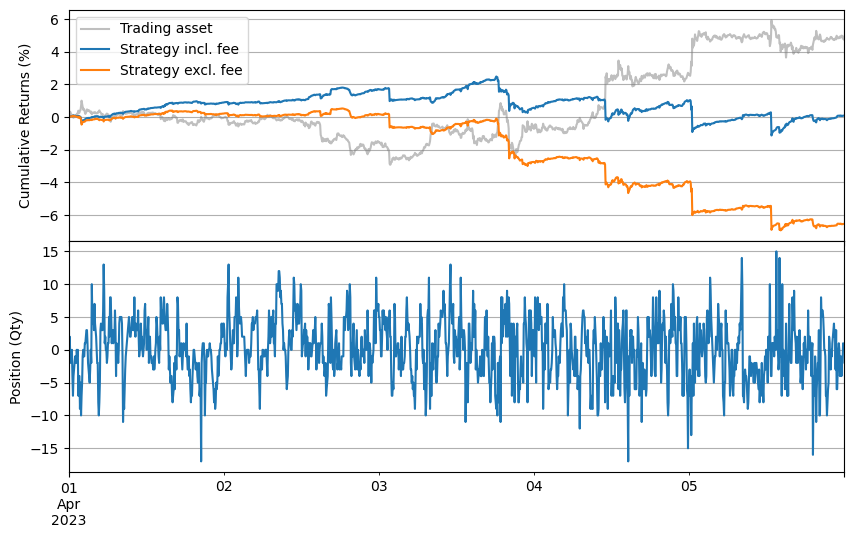Impact of Order Latency
This example illustrates the impact of order latency on the performance of the strategy.
Note: This example is for educational purposes only and demonstrates effective strategies for high-frequency market-making schemes. All backtests are based on a 0.005% rebate, the highest market maker rebate available on Binance Futures. See Binance Upgrades USDⓢ-Margined Futures Liquidity Provider Program for more details.
[1]:
from numba import njit
import numpy as np
from numba.typed import Dict
from hftbacktest import (
HftBacktest,
NONE,
NEW,
GTX,
BUY,
SELL,
ConstantLatency,
FeedLatency,
IntpOrderLatency,
SquareProbQueueModel,
Linear,
Stat
)
@njit
def measure_trading_intensity(order_arrival_depth, out):
max_tick = 0
for depth in order_arrival_depth:
if not np.isfinite(depth):
continue
# Sets the tick index to 0 for the nearest possible best price
# as the order arrival depth in ticks is measured from the mid-price
tick = round(depth / .5) - 1
# In a fast-moving market, buy trades can occur below the mid-price (and vice versa for sell trades)
# since the mid-price is measured in a previous time-step;
# however, to simplify the problem, we will exclude those cases.
if tick < 0 or tick >= len(out):
continue
# All of our possible quotes within the order arrival depth,
# excluding those at the same price, are considered executed.
out[:tick] += 1
max_tick = max(max_tick, tick)
return out[:max_tick]
@njit
def linear_regression(x, y):
sx = np.sum(x)
sy = np.sum(y)
sx2 = np.sum(x ** 2)
sxy = np.sum(x * y)
w = len(x)
slope = (w * sxy - sx * sy) / (w * sx2 - sx**2)
intercept = (sy - slope * sx) / w
return slope, intercept
@njit
def compute_coeff(xi, gamma, delta, A, k):
inv_k = np.divide(1, k)
c1 = 1 / (xi * delta) * np.log(1 + xi * delta * inv_k)
c2 = np.sqrt(np.divide(gamma, 2 * A * delta * k) * ((1 + xi * delta * inv_k) ** (k / (xi * delta) + 1)))
return c1, c2
@njit
def gridtrading_glft_mm(hbt, stat):
arrival_depth = np.full(10_000_000, np.nan, np.float64)
mid_price_chg = np.full(10_000_000, np.nan, np.float64)
t = 0
prev_mid_price_tick = np.nan
mid_price_tick = np.nan
tmp = np.zeros(500, np.float64)
ticks = np.arange(len(tmp)) + .5
A = np.nan
k = np.nan
volatility = np.nan
gamma = 0.05
delta = 1
adj1 = 1
adj2 = 0.05
order_qty = 1
max_position = 20
grid_num = 20
# Checks every 100 milliseconds.
while hbt.elapse(100_000):
#--------------------------------------------------------
# Records market order's arrival depth from the mid-price.
if not np.isnan(mid_price_tick):
depth = -np.inf
for trade in hbt.last_trades:
side = trade[3]
trade_price_tick = trade[4] / hbt.tick_size
if side == BUY:
depth = np.nanmax([trade_price_tick - mid_price_tick, depth])
else:
depth = np.nanmax([mid_price_tick - trade_price_tick, depth])
arrival_depth[t] = depth
hbt.clear_last_trades()
prev_mid_price_tick = mid_price_tick
mid_price_tick = (hbt.best_bid_tick + hbt.best_ask_tick) / 2.0
# Records the mid-price change for volatility calculation.
mid_price_chg[t] = mid_price_tick - prev_mid_price_tick
#--------------------------------------------------------
# Calibrates A, k and calculates the market volatility.
# Updates A, k, and the volatility every 5-sec.
if t % 50 == 0:
# Window size is 10-minute.
if t >= 6_000 - 1:
# Calibrates A, k
tmp[:] = 0
lambda_ = measure_trading_intensity(arrival_depth[t + 1 - 6_000:t + 1], tmp)
lambda_ = lambda_[:70] / 600
x = ticks[:len(lambda_)]
y = np.log(lambda_)
k_, logA = linear_regression(x, y)
A = np.exp(logA)
k = -k_
# Updates the volatility.
volatility = np.nanstd(mid_price_chg[t + 1 - 6_000:t + 1]) * np.sqrt(10)
#--------------------------------------------------------
# Computes bid price and ask price.
c1, c2 = compute_coeff(gamma, gamma, delta, A, k)
half_spread = (c1 + 1 / 2 * c2 * volatility) * adj1
skew = c2 * volatility * adj2
bid_depth = half_spread + skew * hbt.position
ask_depth = half_spread - skew * hbt.position
# If the depth is invalid, set a large spread to prevent execution.
if not np.isfinite(bid_depth):
bid_depth = 1_000
if not np.isfinite(ask_depth):
ask_depth = 1_000
bid_price = min(round(mid_price_tick - bid_depth), hbt.best_bid_tick) * hbt.tick_size
ask_price = max(round(mid_price_tick + ask_depth), hbt.best_ask_tick) * hbt.tick_size
grid_interval = round(max(half_spread, 1)) * hbt.tick_size
bid_price = np.floor(bid_price / grid_interval) * grid_interval
ask_price = np.ceil(ask_price / grid_interval) * grid_interval
#--------------------------------------------------------
# Updates quotes.
hbt.clear_inactive_orders()
# Creates a new grid for buy orders.
new_bid_orders = Dict.empty(np.int64, np.float64)
if hbt.position < max_position:
for i in range(grid_num):
bid_price -= i * grid_interval
bid_price_tick = round(bid_price / hbt.tick_size)
# order price in tick is used as order id.
new_bid_orders[bid_price_tick] = bid_price
for order in hbt.orders.values():
# Cancels if an order is not in the new grid.
if order.side == BUY and order.cancellable and order.order_id not in new_bid_orders:
hbt.cancel(order.order_id)
for order_id, order_price in new_bid_orders.items():
# Posts an order if it doesn't exist.
if order_id not in hbt.orders:
hbt.submit_buy_order(order_id, order_price, order_qty, GTX)
# Creates a new grid for sell orders.
new_ask_orders = Dict.empty(np.int64, np.float64)
if hbt.position > -max_position:
for i in range(grid_num):
ask_price += i * grid_interval
ask_price_tick = round(ask_price / hbt.tick_size)
# order price in tick is used as order id.
new_ask_orders[ask_price_tick] = ask_price
for order in hbt.orders.values():
# Cancels if an order is not in the new grid.
if order.side == SELL and order.cancellable and order.order_id not in new_ask_orders:
hbt.cancel(order.order_id)
for order_id, order_price in new_ask_orders.items():
# Posts an order if it doesn't exist.
if order_id not in hbt.orders:
hbt.submit_sell_order(order_id, order_price, order_qty, GTX)
t += 1
if t >= len(arrival_depth) or t >= len(mid_price_chg):
raise Exception
# Records the current state for stat calculation.
stat.record(hbt)
Order Latency from Feed Latency
[2]:
hbt = HftBacktest(
[
'data/ethusdt_20230401.npz',
'data/ethusdt_20230402.npz',
'data/ethusdt_20230403.npz',
'data/ethusdt_20230404.npz',
'data/ethusdt_20230405.npz',
],
tick_size=0.01,
lot_size=0.001,
maker_fee=-0.00005,
taker_fee=0.0007,
order_latency=FeedLatency(),
queue_model=SquareProbQueueModel(),
asset_type=Linear,
snapshot='data/ethusdt_20230331_eod.npz',
trade_list_size=10_000
)
stat = Stat(hbt)
gridtrading_glft_mm(hbt, stat.recorder)
stat.summary(capital=25_000)
Load data/ethusdt_20230401.npz
Load data/ethusdt_20230402.npz
Load data/ethusdt_20230403.npz
Load data/ethusdt_20230404.npz
Load data/ethusdt_20230405.npz
=========== Summary ===========
Sharpe ratio: 4.6
Sortino ratio: 3.3
Risk return ratio: 43.1
Annualised return: 119.45 %
Max. draw down: 2.77 %
The number of trades per day: 3212
Avg. daily trading volume: 3212
Avg. daily trading amount: 5886441
Max leverage: 3.40
Median leverage: 0.22

Historical Order Latency
[3]:
latency_data = np.concatenate(
[np.load('../latency/ethusdt_{}_latency.npz'.format(date))['data'] for date in range(20230401, 20230406)]
)
hbt = HftBacktest(
[
'data/ethusdt_20230401.npz',
'data/ethusdt_20230402.npz',
'data/ethusdt_20230403.npz',
'data/ethusdt_20230404.npz',
'data/ethusdt_20230405.npz',
],
tick_size=0.01,
lot_size=0.001,
maker_fee=-0.00005,
taker_fee=0.0007,
order_latency=IntpOrderLatency(data=latency_data),
queue_model=SquareProbQueueModel(),
asset_type=Linear,
snapshot='data/ethusdt_20230331_eod.npz',
trade_list_size=10_000
)
stat = Stat(hbt)
gridtrading_glft_mm(hbt, stat.recorder)
stat.summary(capital=25_000)
Load data/ethusdt_20230401.npz
Load data/ethusdt_20230402.npz
Load data/ethusdt_20230403.npz
Load data/ethusdt_20230404.npz
Load data/ethusdt_20230405.npz
=========== Summary ===========
Sharpe ratio: 0.4
Sortino ratio: 0.3
Risk return ratio: 2.8
Annualised return: 11.03 %
Max. draw down: 4.00 %
The number of trades per day: 3493
Avg. daily trading volume: 3493
Avg. daily trading amount: 6401297
Max leverage: 2.47
Median leverage: 0.22

Order Latency from Amplified Feed Latency
[4]:
hbt = HftBacktest(
[
'data/ethusdt_20230401.npz',
'data/ethusdt_20230402.npz',
'data/ethusdt_20230403.npz',
'data/ethusdt_20230404.npz',
'data/ethusdt_20230405.npz',
],
tick_size=0.01,
lot_size=0.001,
maker_fee=-0.00005,
taker_fee=0.0007,
order_latency=FeedLatency(entry_latency_mul=4, resp_latency_mul=3),
queue_model=SquareProbQueueModel(),
asset_type=Linear,
snapshot='data/ethusdt_20230331_eod.npz',
trade_list_size=10_000
)
stat = Stat(hbt)
gridtrading_glft_mm(hbt, stat.recorder)
stat.summary(capital=25_000)
Load data/ethusdt_20230401.npz
Load data/ethusdt_20230402.npz
Load data/ethusdt_20230403.npz
Load data/ethusdt_20230404.npz
Load data/ethusdt_20230405.npz
=========== Summary ===========
Sharpe ratio: 0.2
Sortino ratio: 0.2
Risk return ratio: 1.8
Annualised return: 6.66 %
Max. draw down: 3.61 %
The number of trades per day: 3193
Avg. daily trading volume: 3193
Avg. daily trading amount: 5849525
Max leverage: 4.57
Median leverage: 0.22
